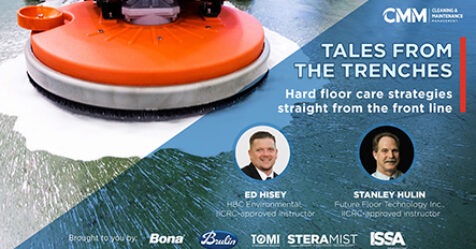Floor care is crucial to all facilities, as clean floors help maintain a high standard of hygiene. Since floors are among the first areas people see when they enter a building, the condition of your floors greatly impact visitors’ overall impression of your facility. Keeping floors debris-free and clean will enhance and protect your brand.
The sustainability of your floor care program is also important, as floors can have a significant impact on a facility’s environmental footprint. Traditional commercial floor care cleaning methods often involve the use of chemicals, excessive water consumption, and unnecessary water runoff, all of which impact the environment and indoor air quality (IAQ). Additionally, if your floor care program uses machines that are difficult to handle and not ergonomically designed, they could decrease worker productivity and impact employee morale.
Fortunately, technological innovations and digitalization have found their way into the cleaning industry, changing cleaning machines for the better. This technology, along with customer priorities, has driven floor machine manufacturers to create equipment that saves resources, improves ergonomics and safety, and enhances operational efficiency.
Many floor care machines now offer sustainable features that reduce water, energy, and chemical consumption. Consumers can now choose equipment that prioritizes responsible manufacturing and a sustainable supply chain.
Innovate, improve, innovate again
When reviewing the sustainability of a product, it makes sense to analyze it completely, beginning with the machine design and including its manufacturing process, supply chain issues, intended use, and its end-of-life options. All of these stages have a major impact on the machine’s carbon dioxide footprint. To lower carbon emissions, it’s important to understand which programs leave the biggest footprint and could benefit from advancement in the market.
Consider the following to establish a sustainable and efficient floor care program:
Prioritize machine design. Extending a product’s lifecycle is a critical component for reducing waste and improving efficiency. Choose durable machines that can be repaired easily to keep them operational and out of the landfill. Consider machines that are manufactured with parts and materials that can be recycled at the end of a machine’s serviceable life. Machines that are manufactured with eco-friendly materials are dually beneficial because they take less resources from the Earth during the manufacturing process and produce less waste at end of life because their parts are recyclable.
Boost your batteries and save energy. The life of your machine can largely depend on its battery type. Lead acid or “wet” batteries are bulky and prone to corrosion that can cause leaks around the terminals over time. Incorrect charging can drastically shorten the battery’s operating life and the run-time of your machine. Improper recycling is also harmful as lead acid batteries may corrode and release lead and lead-contaminated sulfuric acid into the environment, potentially polluting drinking water sources, according to the U.S. Environmental Protection Agency (EPA).
Invest in technology. Using machines with improved technological features such as brushless motors and low voltage can improve your cleaning efficiency while also reducing your carbon footprint. If your battery packs last longer, you can enjoy the same cleaning results while using less power. To realize all the benefits of new battery technology, remember that machines, batteries and chargers must all be in-sync to optimize performance.
Clean up your cleaning solution. Many common cleaning products contain volatile organic compounds (VOCs) to enhance product performance and fragrance. However, exposure to these compounds poses significant health concerns. Short-term effects may include eye, nose, and throat irritation; headaches; nausea; and damage to the liver, kidneys, and central nervous system, according to the EPA. Moreover, VOCs can directly contribute to global warming by absorbing infrared radiation from the earth’s surface, according to an article published in the International Journal of Environmental Research and Public Health.
Many manufacturers offer cleaning formulations specifically developed to incorporate more sustainable ingredients, including plant-based and naturally occurring ingredients. These products will often carry environmental certifications such as Green Seal, GREENGUARD, ECOLOGO, and DFE.
Optimize water usage. Automatic floor scrubbers employ numerous techniques to help reduce water consumption. Some machines are designed to optimize the amount of solution delivered to match the machine’s speed. This helps to reduce waste and trail mopping due to excess solution being dispensed.
Floor scrubber operators do not consistently work at the same pace until they finish a task; it is normal to speed up and slow down during the cleaning process. Advanced floor care systems adjust to the user’s speed in real time to use less cleaning solution when needed. These adjustments decrease water consumption by up to 67%, reduce time-consuming tank fills, and lower costs.
In addition to saving the amount of water and cleaning products used, advanced floor care system features make it easier for the squeegee mechanism to remove dirty solution from the floor on the first pass. Eliminating the need for a second pass saves time and helps to reduce labor costs.
Limit product wastage. Modern floor care machines are designed to optimize product use through on-board dilution control systems that dose chemicals accurately and consistently. Improperly dosed formulas that are too weak will provide poor results and require a repeat clean, which will require additional product, water and energy and result in lost productivity. Solutions that are too strong can leave residues on the floor that require additional rinsing and another pass of the machine in drying mode. Eliminating manual dosing removes operator guesswork.
Implement chemical-free floor care
Water is all you’ll need when using floor care equipment such as auto scrubbers and single disc machines that are fitted with special pads that incorporate millions of microscopic diamonds. The diamonds gently scrub the surface of the floor. Pad color designates the diamond size, with each size suited for a specific task, from deep cleaning and renovation to polishing. Some manufacturers offer pads that are made from recycled plastics, further enhancing their sustainability credentials.
As floor care often represents a significant part of building care, it offers a variety of options for sustainability enhancements. Innovative floor care machines deliver high productivity with minimal resource consumption. By choosing cutting-edge products and equipment and streamlining cleaning processes, you can reduce costs and your facility’s impact on the environment.



